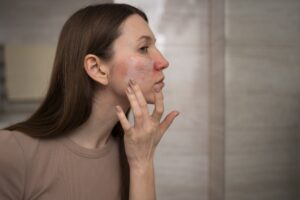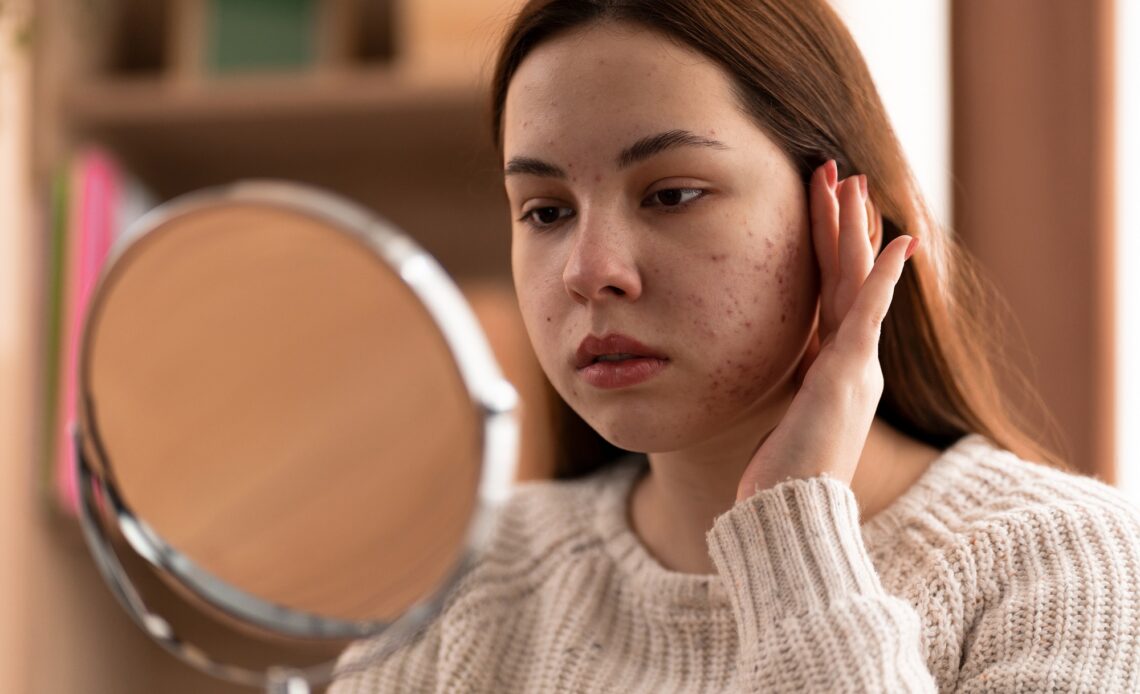Introduction
In the realm of dermatology, our skin serves as a mirror, reflecting not only our overall health but also the numerous challenges it faces. From common skin problems that afflict many of us to the unique charm of freckles, our skin’s condition can be a powerful indicator of well-being. In this blog post, we embark on a journey to explore the subtle yet often significant signs our skin can reveal. We’ll dive deep into the common symptoms of various skin issues and celebrate the distinctive beauty of freckles, shedding light on what these marks can signify about our skin’s health. Whether you’re seeking insights into managing skin conditions or simply curious about the world of freckles, join us in unraveling the mysteries of our body’s most visible canvas.
Common Symptoms of Skin Problems
Rashes:
Rashes constitute a wide-ranging category of skin conditions marked by noticeable alterations in the skin’s color, texture, or overall appearance. These changes can encompass a diverse spectrum of visual and sensory characteristics. Rashes may take on the form of red, inflamed patches that often provoke itching, discomfort, or even pain. They can also appear as swollen areas, sometimes exhibiting a scaly or rough texture. Rashes result from diverse causes like allergies, infections (fungal or bacterial), or chronic skin conditions like eczema or psoriasis. Rashes vary in size, shape, and distribution, their appearance closely tied to the underlying cause. Precise diagnosis and focused treatment are vital for managing rashes, ensuring comfort, and preserving skin health.

Itching (Pruritus):
Persistent itching, medically known as pruritus, is a frequently encountered symptom in the realm of skin problems, contributing to the discomfort and distress experienced by individuals. Itching can manifest along a spectrum of intensity, ranging from mild and occasional discomfort to severe and relentless irritation. Scratching may briefly soothe, but can harm the skin, causing redness, inflammation, and even open sores. Skin issues that commonly feature itching as a prominent symptom encompass a diverse range, such as eczema, a chronic inflammatory condition marked by itchy, red, and sometimes scaly skin; contact dermatitis, which arises from exposure to allergens or irritants and triggers itching, redness, and swelling; and fungal infections like athlete’s foot, which provoke intense itching, especially between the toes. Pruritus, both physically uncomfortable and life-affecting, plays a pivotal role in diagnosing and managing diverse skin conditions.
Redness (Erythema):
Erythema, skin redness, signals inflammation and can result from various triggers. Skin conditions can result from infections, allergies, autoimmune diseases (e.g., lupus), or exposure to irritants like chemicals or pollen. Erythema’s appearance ranges from mild, fleeting redness to severe, persistent cases, determined by the cause and skin sensitivity. Erythema can appear in small or large areas, showing its versatility as a notable symptom. Often accompanied by warmth and tenderness in the affected area, erythema is an important clinical sign that dermatologists and healthcare professionals consider during diagnostic assessments to pinpoint the root cause and determine the most appropriate course of treatment for the underlying condition.
Dryness and Flaking:
Dryness and flaking of the skin represent prevalent symptoms in various skin-related issues, with conditions like xerosis (dry skin) and eczema prominently featuring these discomforting characteristics. In such cases, the skin’s natural moisture balance becomes disrupted, resulting in a loss of hydration and suppleness. This deficiency leads to dryness, which is often accompanied by a rough and uneven texture, making the skin appear scaly and flaky. The discomfort doesn’t stop there; dry skin can also induce persistent itching, which can be particularly bothersome. To manage these symptoms and restore skin comfort, individuals frequently resort to the application of moisturizers, which help replenish lost moisture, soothe irritation, and enhance the skin’s overall health and appearance.
Bumps and Lumps:
Skin issues often give rise to a diverse array of irregularities on the skin’s surface, collectively referred to as bumps and lumps. These anomalies encompass a spectrum of shapes, sizes, and compositions. Among them are papules, which are small, raised bumps that can be firm or tender to the touch. Pustules, on the other hand, are characterized by their content of pus, appearing as red, swollen bumps filled with a yellow or white fluid. Nodules are larger and typically solid lumps that reside beneath the skin, often requiring deeper examination for diagnosis. Lastly, cysts present as sac-like structures that contain fluid or semi-solid material. Dermatologists rely on the distinct characteristics, such as size, texture, color, and distribution, of these skin irregularities to aid in diagnosing the underlying skin condition. These bumps and lumps can be indicators of various dermatological issues, including acne, lipomas, cystic acne, or even more serious conditions, and prompt medical evaluation is essential for accurate diagnosis and appropriate treatment.
Changes in Pigmentation:
Skin conditions such as vitiligo and melasma can induce significant alterations in skin pigmentation. Vitiligo is characterized by the progressive loss of skin pigment, leading to the formation of white or depigmented patches on the skin. In contrast, melasma involves the development of darker, pigmented patches, frequently arising due to hormonal fluctuations, pregnancy, birth control use, or sun exposure. These fluctuations in pigmentation can significantly impact an individual’s skin tone and overall appearance, and they can be emotionally challenging for those affected. While vitiligo results in the loss of melanin-producing cells, causing white patches, melasma involves the overproduction and irregular distribution of melanin, leading to the appearance of darker, often symmetrical patches on the face. Both conditions can benefit from specialized dermatological care and, in some cases, treatments designed to regulate pigmentation and enhance skin aesthetics.
Sensitivity to Sunlight:
In certain skin conditions, the skin’s sensitivity to sunlight becomes heightened, increasing the risk of sunburn and exacerbating existing skin issues. This heightened sensitivity is particularly evident in conditions like photosensitivity reactions, rosacea, or specific types of dermatitis. When the skin is photosensitive, exposure to ultraviolet (UV) radiation from the sun can trigger adverse reactions, leading to redness, inflammation, and discomfort. Consequently, effective sun protection measures are paramount in managing this symptom. These measures include the regular application of sunscreen with a high SPF, seeking shade during peak sunlight hours, and wearing protective clothing like wide-brimmed hats and long sleeves to shield the skin from harmful UV rays. Managing sun sensitivity is essential not only for preventing discomfort but also for maintaining overall skin health and minimizing the risk of long-term damage.
Understanding these common symptoms of skin problems is essential for early diagnosis, effective treatment, and maintaining skin health. If you experience any of these symptoms or have concerns about your skin’s condition, it’s advisable to consult a dermatologist or healthcare provider for a proper evaluation and guidance. Skin problems can sometimes be indicators of underlying kidney disease, emphasizing the importance of holistic health assessment.
Common Symptoms of Freckles
Small, Flat Spots:

Freckles, those charming and often endearing skin characteristics, are known for their distinct appearance. Typically, they manifest as small, flat, and circular spots gracing the skin’s surface. These spots are characterized by their tan, light brown, or occasionally reddish hues, and they measure anywhere from the size of a pinhead to a few millimeters in diameter. It is the combination of their round, symmetrical shape and flat profile that sets freckles apart from other skin irregularities. This unique visual trait, along with their tendency to darken with sun exposure, makes freckles a characteristic and sometimes whimsical aspect of an individual’s complexion.
More Pronounced in Sun-Exposed Areas:
Freckles exhibit a unique response to sun exposure, often becoming more pronounced in areas of the skin that regularly encounter the sun’s ultraviolet (UV) radiation. This heightened visibility is particularly prominent on the face, with freckles tending to cluster on the cheeks and nose, where UV exposure is frequent. Additionally, the neck, arms, and shoulders are common locations for freckles to emerge due to their consistent exposure to sunlight. Over time, the cumulative effect of UV radiation leads to the development and darkening of freckles in these sun-exposed regions. This distinctive reaction underscores the close relationship between freckles and sun exposure, emphasizing the importance of sun protection to mitigate their appearance and reduce the risk of UV-related skin damage.
Multiple Freckles:
Freckles are commonly observed in clusters or groups rather than appearing in isolation on the skin’s surface. This clustering of freckles is particularly noticeable in individuals with fair or light skin, as their skin is inherently more sensitive to the effects of ultraviolet (UV) radiation from the sun. Freckle clusters vary in size and density, commonly appearing on sun-exposed areas like the face, neck, arms, and shoulders. This propensity for multiple freckles is a result of the skin’s natural response to UV exposure, where melanin is produced and deposited in small concentrations, resulting in the characteristic appearance of freckles. While freckles are generally harmless, they serve as a visible reminder of the skin’s vulnerability to UV rays and the importance of sun protection measures to prevent their formation and reduce the risk of sun-related skin damage.
Darkening with Sun Exposure:
Darkening with sun exposure is a distinctive characteristic of freckles. These small, flat spots on the skin display a remarkable reaction when exposed to sunlight. UV radiation from the sun activates melanocytes, prompting melanin production, responsible for skin color. As a result of this sun-triggered melanin production, freckles tend to intensify in color and become more pronounced when exposed to sunlight. This change can lead to freckles appearing darker and more noticeable on the skin during the summer months or after sun exposure. Conversely, during periods of reduced sun exposure, such as in winter, freckles often fade or become less prominent as melanin production decreases. Understanding this dynamic response to sunlight is important for individuals with freckles, emphasizing the need for sun protection measures to minimize their darkening and reduce the risk of UV-related skin damage.
No Other Symptoms:
Freckles are typically harmless, lacking accompanying symptoms, unlike many other skin conditions. Freckles are harmless pigmented spots, typically without discomfort, itching, or pain, in contrast to other skin issues. Skin changes due to sun exposure, like darkening or fading, are often aesthetic and rarely indicate a medical issue. Freckles are a testament to the skin’s diverse responses to sunlight and genetics, offering unique character without the distressing symptoms commonly associated with various other skin conditions.
Freckles are a unique and characteristic feature of some individuals’ skin, and they are usually considered harmless. However, it’s important to be aware of any changes in the appearance of freckles, as unusual alterations or new freckles could potentially warrant medical evaluation. Regular use of sunscreen and sun protection measures is recommended to minimize the darkening of freckles and reduce the risk of UV-related skin damage.
When to Seek Medical Attention
If you notice any unusual or concerning changes in your skin, it’s important to consult a dermatologist or healthcare professional. Here are some situations in which you should seek medical attention:
Sudden or Rapid Changes:
Any sudden or rapid changes in the appearance of skin problems or freckles should be a cause for concern. This includes alterations in size, color, shape, or texture. If you notice that a freckle has grown significantly larger, changed color dramatically, or become irregular in shape, it is advisable to consult a healthcare provider promptly. Rapid changes may signal potential issues that require medical evaluation.
Persistent Symptoms:
When skin problems or freckles are accompanied by persistent and bothersome symptoms, it’s crucial to seek medical advice. Symptoms such as itching, redness, discomfort, or pain that do not improve with over-the-counter treatments or home remedies may indicate an underlying skin condition or infection that requires professional assessment and treatment.
Family History:
If you have a family history of skin cancer or other serious skin conditions, proactive skin monitoring is essential. Regular skin checks with a dermatologist should be a routine part of your healthcare. People with a family history of skin cancer may have an increased risk of developing skin cancer themselves, and early detection through regular check-ups can be lifesaving.
New or Changing Moles:
The appearance of new moles or changes in existing moles should be taken seriously. Moles that are irregular in shape, have uneven borders, exhibit a variety of colors, or have a diameter larger than a pencil eraser (6 mm or more) may raise concerns. Such changes can be potential indicators of skin cancer, and it is imperative to have them evaluated by a healthcare professional. Regular mole checks can help detect skin cancer at an early, more treatable stage.
In summary, vigilance and proactive care are essential when it comes to skin problems and freckles. Any sudden or concerning changes, persistent symptoms, family history of skin conditions, or alterations in moles should prompt you to seek medical attention promptly. Timely assessment by a dermatologist enhances outcomes in addressing skin concerns, including possible skin cancer, through early detection and intervention.
Conclusion
In conclusion, developing a comprehensive understanding of the common symptoms linked to both skin problems and freckles is of paramount importance for maintaining optimal skin health. While freckles are generally benign and merely a unique feature of some individuals’ skin, it’s crucial to recognize that skin problems encompass a broader spectrum, spanning from mild to severe conditions that may necessitate medical intervention. By being aware of these symptoms, individuals can take proactive steps towards early diagnosis and effective management of any skin-related issues they encounter. This proactive approach involves two key components: regular self-examinations and timely professional consultations.
Firstly, regular self-examinations of your skin allow you to become familiar with your skin’s normal appearance and to detect any deviations or abnormalities promptly. By checking your skin periodically, you can monitor the presence, size, and changes in freckles, moles, or other skin features. This self-awareness empowers you to notice and act upon any sudden or concerning alterations, ensuring that potential issues are addressed early.
Secondly, professional consultations with a dermatologist or healthcare provider play a pivotal role in maintaining skin health. Dermatologists possess specialized knowledge and expertise in diagnosing and treating various skin conditions, including skin cancer. Regular appointments with a dermatologist, especially if you have a family history of skin issues or skin cancer, can lead to early detection and intervention, significantly improving the likelihood of successful treatment and positive outcomes.
In essence, being vigilant about your skin’s well-being and promptly seeking medical attention when needed are fundamental components of responsible skin care. By doing so, you can not only ensure the timely management of any skin problems but also gain peace of mind knowing that you are actively safeguarding your skin health for the long term.


